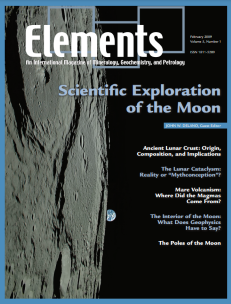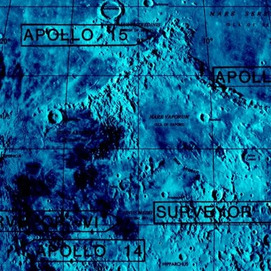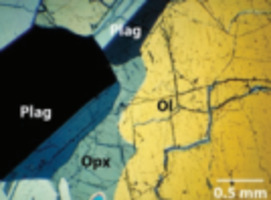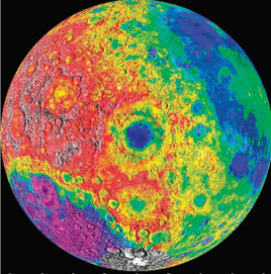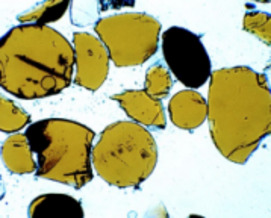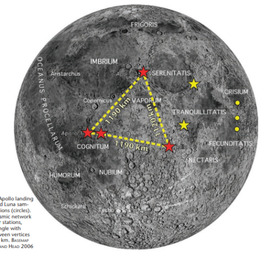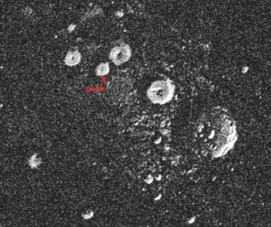
Scientific Exploration of the Moon
John W. Delano – Guest Editors
Table of Contents
Our current understanding of the Moon’s history, interior structure, and chemical composition is based in large part on geochemical data acquired from samples from the U.S. Apollo and Soviet Luna missions; data acquired by Apollo geo physical instruments; orbital geochemi cal and spectral data acquired by robotic missions from the U.S., Japan, and Chi na; analysis of lunar meteorites derived from previously unsampled regions of the Moon; and Earthbased radar obser vations and infrared spectral reflectance data. All of these efforts have contribut ed to a preliminary understanding of the origin of the Moon and the process es that have affected its surface and inte rior. Isotopic analyses of impactgener ated samples have placed constraints on the timedependent meteorite flux that not only affected the Moon but also the Earth and other objects in the inner solar system. In this issue of Elements, leading scientists discuss the major concepts that underpin our current understanding of the Moon, as well as scientific plans for international scientific exploration by robotic and human missions.
Scientific Exploration of the Moon
Ancient Lunar Crust: Origin, Composition, and Implications
The Lunar Cataclysm: Reality or “Mythconception”?
Lunar Mare Volcanism: Where Did the Magmas Come From?
The Interior Structure of the Moon: What Does Geophysics Have to Say?
The Poles of the Moon
Australian Scientific Instruments (ASI)
Cambridge University Press
CrystalMaker
Excalibur Mineral Corporation
RockWare
Savillex
Smart Elements
Thermo Scientific (Part of Thermo Fisher Scientific)
v5n2 Bentonites – Versatile Clays
Guest editor: Derek C. Bain (The Macaulay Institute)
Of all naturally occurring clays, benton ites are arguably the most interesting, versatile and useful. This issue of Elements describes how these fascinating materi als occur and how they are used in all manner of applications. Composed pre dominantly of swelling minerals (smec tites) and formed mainly from the alter ation of volcanoclastic rocks, bentonites are used by geologists for stratigraphic correlation. Bentonite deposits are mined worldwide as they are commercially very valuable. Because of their physicochemi cal properties, bentonites are used in a wide variety of industrial applications, including the drilling industry, found ries, civil engineering, adsorbents, filter ing, etc. Recent formulations of polymer– smectite nanocomposites have been used in industry to make new materials with amazing properties and diverse applications. Bentonites play an important role in the protection of the environment from industrial waste and pollutants and have also been used in medical applications in human health.
Bentonite and Its Impact on Modern Life Don D. Eisenhour (Amcol International) and Richard K. Brown (WyoBen Inc.)
- Bentonites – Clays for Molecular Engineering Necip Güven (Texas Tech University)
- Geological Aspects and Genesis of Bentonites George E. Christidis (Technical University of Crete) and Warren D. Huff (University of Cincinnati)
- Bentonite, Bandaids, and Borborygmi Lynda B. Williams (Arizona State University), Shelley E. Haydel (Arizona State University) and Ray E. Ferrell Jr. (Louisiana State University)
- Bentonite Clay Keeps Pollutants at Bay Will P. Gates (Monash University), Abdelmalek Bouazza (Monash University) and G. Jock Churchman (University of Adelaide)
- Acid Activation of Bentonites and Polymer–Clay Nanocomposites Kathleen A. Carrado (Argonne National Laboratory) and Peter Komadel (Slovak Academy of Sciences)
- Scientific Exploration of the Moon (February 2009)
- Bentonites – Versatile Clays (April 2009)
- Gems (June 2009)
- Mineral Magmatism: From Microbes to Meteorites (August 2009)
- Gold (October 2009)
- Metal Stable Isotopes: Signals in the Environment (December 2009)
Download 2009 Thematic Preview


